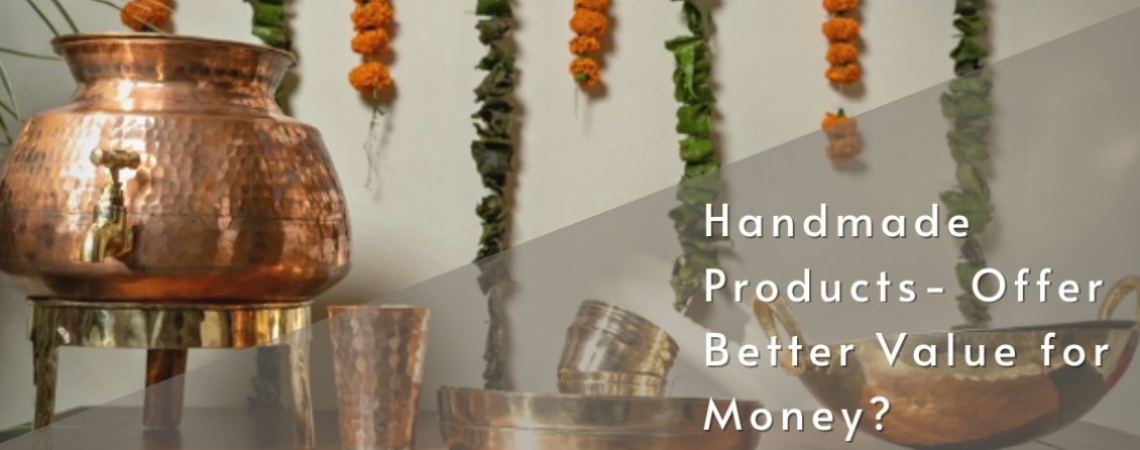In a world where industrialization has prevailed for quite a few centuries now and the number of manufacturing industries has grown exponentially, there is still a small but tenacious industry of skilled craftsmen keeping the heart of our illustrious culture and legacy alive. This is the Handmade Industry, which survives by selling the skill that has been passed down and honed over many generations. A handcrafted item is more than just a functional item; it represents the artist's heart and is the product of his or her days of experimenting, grit, and determination. Something that was done by hand is always more thoughtful and has a deeper meaning. But do these handmade products offer better value for money?
In the market, you’ll find both kinds of items, handmade and machine-made. The former items will often be more expensive in comparison to the latter. This might be a concern for many people that if they can get the duplicate copy for half the price, why pay more to buy the original handmade items? But, it should be kept in mind that the charm and warmth that handmade items bring are unmatched. They have a different zeal which machine-made ones don’t.
After the boom in mass-production industries, handmade items have now started to face the scrutiny of being considered expensive. But we can’t deny the fact that handmade items can be expensive but never over-priced. An artisan understands the value of the time, patience, labor, and hard work that has been put into the production of every single piece and charges only what he is worthy of. They don’t sell their products for purely profit and business purposes, instead, they are connected to that art emotionally and want it to propagate. Whereas, mass-production units where multiple copies of a product are generated work entirely for huge gain margins. Let us look at the factors that make handmade products a bit more expensive.
Handicrafts are art and thus require a lot of creativity and imagination which can’t be weighed in money. It is up to the ingenuity and creativity of the individual to choose the color, design pattern, and size that will make the item appear marketable. Beautifully imagined paintings and other works of art are sold for millions of rupees for this reason, and customers are happy to purchase them for their unrivaled beauty. That’s the price the artist deserves for their skill which took years of hard work and resilience to develop and result in that art.
Handmade products come with an air of freshness. They offer uniqueness and authenticity. No two products are the same, unlike the large-scale industry items that are just duplicates of each other and give no sense of identity to the individual buying them. So, the price you pay for a handmade product is the reward for the way it makes you feel. When people purchase and value these products over those produced by factories, it not only helps those artists to survive but also increases their confidence and faith in their abilities.
The time spent in the production of handmade items is also greater. A machine can roll thousands of products out of the assembly line when a craftsman is busy making one. It takes a good amount of time in the entire process of crafting a single piece. Also, the creation of handmade things involves craftsmen at every stage. Machines can’t possess the knowledge of the skill that goes into making the item, but a skilled worker does. They take care of the minutest of details and ensure that the quality of the product is never compromised. Even if there’s a mistake or defect in the product, it is either fixed properly or discarded, but this can’t be guaranteed in the case of factory-made products that are recklessly rolled out of the assembly line in bulk. The craftsmen accomplish everything, including choosing the material, considering the design and the colors that go with it, and constructing the finished product. However, there is still work to be done because they must be carefully brought to market. For this, the craftsmen are in charge of the product's marketing, package design, and retail location. Getting these works of art to the clients takes a lot of effort and time increasing the price of the product.
Last and most importantly, the ingredients or materials used for the production of handmade products are of the best quality. Artisans often use hand-picked materials like the most resilient bamboo for Manipuri bamboo crafts which include sofa sets, the most exquisite piece of finished walnut for Kashmiri walnut wood carving, or the organic cotton grown in the Nimar region of Madhya Pradesh for Maheshwari Sarees. They ensure that the raw materials used are of excellent grade and locally sourced, which even supports the local farmers and strengthens the economy. In contrast, mass-produced items have the tendency to maximize profits and quantity and thus ignore the quality of the item due to which handmade products last longer and have better durability than machine-made ones.
So, circling back to our concern, the sale of handmade products should be encouraged even if they are a little expensive because it’s worth it, and offers better value for money. It’s the best of the best and ever-lasting. If an extra penny can add a whole new and good vibe to your home or life, why not? So embrace handmade products and you’ll never regret it.
After all GOOD THINGS COME WITH A PRICE!











